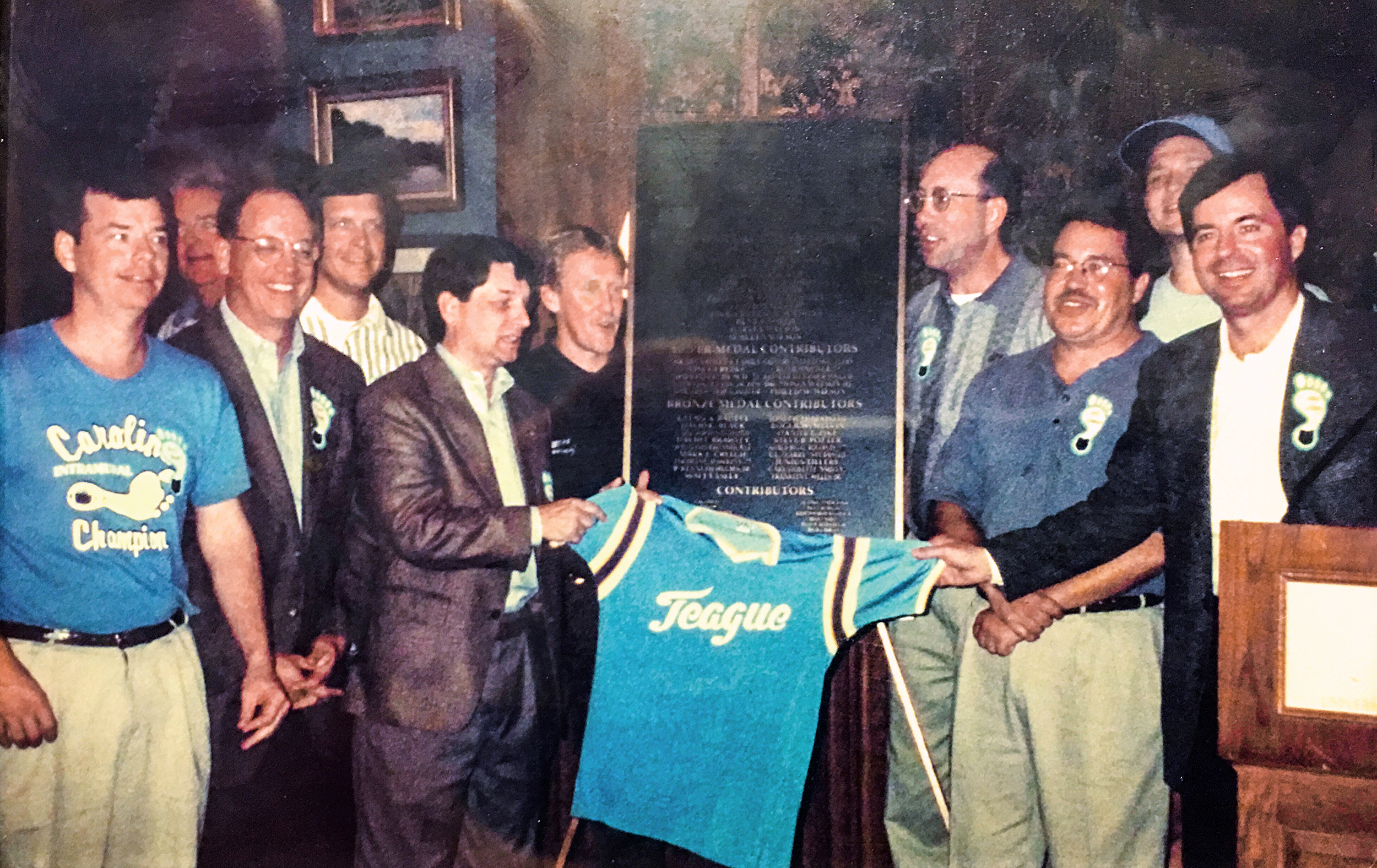From the Heart: If Mighty Teague Falls …
Posted on April 26, 2019
The athletes who were part of Teague’s intramural dynasty honored the varsity sports side and Teague alumnus Anson Dorrance ’74 (not pictured) with a plaque that commemmorates the success of Dorrance’s women’s soccer program. Teague may go away, they say, but not the memories and lifelong friendships. (Photo courtesy of Freddie Kiger ’74)
Tucked away in the field entrance of the McCaskill Soccer Center, there is a plaque that reads: Teague Dorm (perennial Residence Hall Intramural Champions), as the symbol of Intramural excellence at UNC, would like to recognize another athletic dynasty, the UNC Women’s Soccer team and former Teague alumnus, Anson Dorrance, for his role in both dynasties.
Both organizations have set a standard of achievement that will probably never be matched. This unparalleled success has provided a sense of discipline, confidence, determination and teamwork that can be seen in the individual members today in their non-sport lives.
With each passing year, our memories become less trustworthy and our accomplishments become accordingly more heroic. Our wish is that our memories continue to decline and our accomplishments continue to rise thereby justifying our self-proclaimed legendary status.
With every recruit, Dorrance ’74 pauses at that site and spins an object lesson. “When I look at the arc of my life,” he said recently, “I am proud to have been part of three sport dynasties: Teague, the U.S. Women’s National Team and UNC women’s soccer. I look at all three equally.”
Perhaps to them, Teague may be nothing more than a mass of brick and mortar. But to us, it is where we came of age. It was where, in the mad dash of youth, we did more than exist. We soared.
Forty-eight years ago, all of that was in the uncertain future when my dad and I pulled up to Teague Residence Hall. On that hot and humid September day, I, a naïve 17-year-old, climbed out of the car, looked up and stared at a three-story inanimate mass of brick and mortar. Little did I realize how much it would enrich my life.
After settling in, I quickly learned from an impassioned intramurals manager that Teague finished second in the overall Intramural Residence Hall standings the previous year. I was told that would not happen again. It didn’t. And it didn’t for the rest of the decade. From 1971 through 1988, Teague won 14 of 18 overall residence hall championships and, by taking the title in four consecutive three-year periods, retired four intramural trophies.
To say we were committed is an understatement. Intramural competition in the 13 sports that comprised the overall program was a passion. Competing became a mantra, and we lived for the chase. In doing so, we forged lifelong friendships. In essence, more than 200 residents became one.
And now we are told that, given trustee approval, Teague and our sister dorm, Parker, which also enjoyed intramural success, will be “redeveloped” — an empty, soulless administrative word for “demolished.” For generations of Teague residents, we are heartbroken.
This is not our first brush with “progress.” Weary of the lock Teague had on the residence hall championships and — to be fair — to counter the numerical advantage that Teague had over smaller residence halls on North Campus, the intramurals office split Teague into two units, Teague A and Teague B. We told the director of intramurals what would happen. The two would finish first and second. And we did. Then, in 1988, the decision was made to make Teague coed. While we came around to understanding why, we also knew that an era of intramurals competition, as we knew it, was over. And now it appears Teague will fall victim to progress or the perception of same.
In this instance, surveys and plans don’t factor in memories. They don’t measure the friendships that grew out of our competitive pursuit, and those ties now include the children of our dorm mates and teammates. We look after each other. When one of our own fell victim to multiple sclerosis, Teague alumni donated more than $10,000 so that his son might go to college. In 1988, Teague alumni contributed more than $100,000 to the UNC women’s soccer program. Champions in intramurals and champions in support of our University.
And yet, campus architects — likely without a sense of who and what we were and what we’ve done — have recommended an action and we await a decision. If only we could settle the question on an intramural field.
We do know this. If given the go-ahead, Teague, the memories and the lifelong friendships will remain.
Perhaps to them, Teague may be nothing more than a mass of brick and mortar. But to us, it is where we came of age. It was where, in the mad dash of youth, we did more than exist. We soared. And from those friendships created, even now, when one of our own stumbles, we’ll have each other to break the fall. As evidenced each time we get together — and we have since the middle of the ’70s, now formally once each year and in groups informally throughout — we remain close. We remain family. We are teammates for life.
No, to us, Teague was never a dormitory. Was never an inanimate mass. We were champions there and, to us, it remains the embodiment of the sweetest four-letter word in the English language. Teague was home.
— Freddie Kiger ’74
Thanks for reading the Carolina Alumni Review
Carolina Alumni members, sign in to continue reading.
Not yet a member? Become one today.
